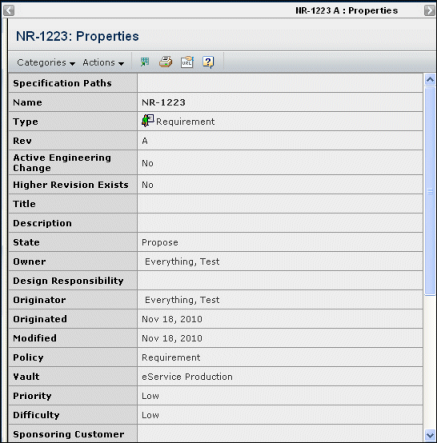Viewing Requirement Properties | ||
| ||
From the list of requirements, click the name of a requirement, or click
 .
.
The Requirements Structure Browser opens. See Using the Requirement Structure Browser.
In the Categories menu, click Properties.

The Properties page lists these details:
Specification Paths.
Name. The identifier for the requirement.
Type. The object classification, in this case, Requirement.
Rev. The revision level.
Active Engineering Change. Whether an engineering change exists for the requirement.
Higher Revision Exists. Whether a more current revision level exists.
Title. A descriptive identifier for the requirement.
Description. Additional information about the requirement.
State. The current state of the requirement in its lifecycle.
Owner. The person responsible for the requirement.
Design Responsibility. The name of the department of a company or business unit that has design responsibility for the requirement.
Originator. The person who created the requirement.
Originated. The date on which the requirement was created.
Modified. The date on which the requirement was last edited.
Policy. The policy governing this requirement.
Vault. The database storage location.
Priority. How important the requirement is: low, medium or high priority.
Difficulty. How difficult the requirement would be to implement: low, medium or high.
Sponsoring Customer. The customer sponsoring the requirement.
Requirement Classification. User classification for this requirement.
Designated User. The designated user of this requirement.
Estimated Cost. The estimated cost to implement this requirement.
User Requirement Importance. The importance classification of this requirement.
Requirement Category. The categorization of this requirement.
Synopsis. A summary of this requirement.
Notes. Any notes that may help others reviewing this requirement.
Reserved By. The person who reserved the requirement.
Reserved Date. The date on which the requirement was reserved.
Reserved Comment. Any comment about the reservation.
Content Text. Any text about the content of the requirement.
Use the Actions menu or page toolbar to work with the requirement:
Edit Details. Click to edit the details of this requirement. See Editing Properties of a Requirement.
Copy. Click to copy the contents of this requirement to make a new requirement. See Copying a Requirement.
Subscribe. Click to subscribe to events for which you would like to be notified, see Working with Subscriptions.
Structure Content Editor. Click to view this requirement in the Structure Content Editor. See Structure & Content Editor.
Use the Categories menu to view additional information about the requirement. See Categories for a Requirement - Structure Browser.